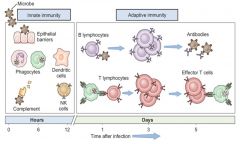![]()
![]()
![]()
Use LEFT and RIGHT arrow keys to navigate between flashcards;
Use UP and DOWN arrow keys to flip the card;
H to show hint;
A reads text to speech;
18 Cards in this Set
- Front
- Back
|
Innate system |
first line of defense: external barrier
second line : cellular and chemical Fast, nonspecific, present at birth physical, chemical, cellular components |
|
|
adaptive system |
third line : target specific pathogens slower, not present at birth, targets specific organisms develops and adapts post exposure antibodies, memory cells, plasma cells, B cells, T cells, |
|
|
Immune system (PIC) |

|
|
|
seroconverison |
antibody levels rise with time
results in false negatives in tests |
|
|
Passive immunity |
placenta or colostrum (24 hours) sometimes human immunoglobulin is used |
|
|
PAMPs |
pathogen associated molecular patterns recognized by PRR's (pathogen-recognition receptors) on macrophases, trigger innate response NOT antigen-antibody |
|
|
Compliment system
|
attach to PAMPS and cause cell lysis opsonize invaders to signal for phagocytosis can bind to antibody COMPLEMENT CASCADE RESULTS IN COMPLEMENT FIXATION (lysis or apoptosis) |
|
|
Cytokines |
chemical signaling molecules interleukins, interferons, chemokines (chemtaxis) |
|
|
Immunoglobulins (5) |
IgM -
IgG IgA IgE IgD MGAED Many girls are EDucated |
|
|
IgM |
first exposure to antigen, temporary, largest |
|
|
IgG |
Smallest and most common Produced and released from plasma cells in response to infection high levels indicative of chronic passive immunity to fetus |
|
|
IgA
|
mucosal surfaces oral or intranasal vaccines |
|
|
IgE |
binds to ALLERGENS and triggers histamine from mast cells and basophils protects from parasitic helminth infections |
|
|
IgD |
activates basophils and mast cells |
|
|
Hypersensitivity reactions : Type 1
|
- animal is sensitized via IgE - 2nd exposure is severe – anaphylaxis - atopy and food allergy as well |
|
|
Hypersensitivity reactions : Type 2 |
- infection present, antibodies, complement - cross-reactive antibodies attack body’s own cells - example: IMHA |
|
|
Hypersensitivity reactions : Type 3 |
- antibody-antigen (immune) complexes form - insoluble complexes deposit and initiate inflammation - example: lupus, vasculitis, glomerulonephritis |
|
|
Hypersensitivity reactions : Type 4 |
caused by intracellular pathogens and accompanied by inflammation - cell-mediated reaction - example: Systemic Inflammatory Response Syndrome (SIRS |

